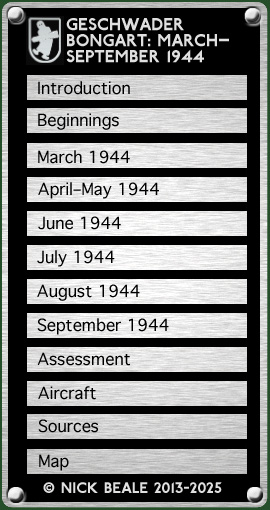|
By taking prompt and energetic action against the resistance groups forming in the interior of France, particularly in the southern part, we have been able to smash the framework of the organsiation for the army of resistance which was being built up and to scatter some of the centres of guerilla activity. It can be established that there is a marked diminution of terrorist activity. Unattributed report of 22 June 1944, deciphered by the Allies Bongart's IV. Gruppe put in an urgent request for a platoon of Landesschützen to guard its dispersals and reported that Bf 110 W.Nr. 3116 was going into the repair shop because of engine problems. The Gruppe was in action on this date, sending out six Ju 88 from 04.45 hrs. to bomb Combovin. German troops were observed advancing 2 km to the west, on the road from Chabeuil, but no people or vehicles were seen in the village itself. The Junkers dropped 56 x SD 50 bombs on the village, reporting the destruction of 40 houses. The bombers (piloted by an Oberleutnant plus Unteroffiziere Bakow, Damske, Hartmand and Mütlein plus another Uffz. whose name is not recorded) landed at at 07.27 hrs., reporting “unbroken cloud over Clermont, no fighters seen.” At 10.00 hrs., 14 Fw 190 from III./SG 4 took off to raid Combovin, Beaufort-sur-Gervanne and Plan-de-Baix, cursorily described in the unit War Diary: “At 12.00 [GMT+2] operation with 14 machines against partisan villages south of Valence”. Plan-de-Baix suffered two dead and seven injured. Seven civilians died in the bombing of Combovin and 10 were injured; one Résistant was killed; the centre of the village was wrecked and German forces inflicted a “bloody repression” on the outlying farms. Le Chaffal was bombed as well. All these targets were on the western fringes of the Vercors Plateau and Resistance forces in Combovin had previously been identified as a threat to Valence aerodrome (see 9–10 June, above). Résistant Jean-François Languillat recalled that German spotter planes from Valence must have remarked the coming and going of Maquis supply trucks. On 22 June René Ladet was in one such gazogène (lorry fuelled by wood gas) approaching Combovin when a farmer warned him that German troops were heading for the village in the wake of an air raid. Six twin-engined aircraft, said to be Dorniers and Heinkels, had begun dropping bombs at 07.30 (local time) and the Germans and Vichy Milice were taking advantage of the confusion to force Maquis barricades and occupy the Combovin plateau. Resistance accounts of attacks from the air are not always unanimous and Marcel Mermoz described the aircraft as “eight Messerschmitts, passing and repassing over us to bomb Combovin.” Alsatian Maquisard “Tony” (Antoine Schrantz): … the weather is marvellous and I’m getting ready to leave for Valence. It’s 07.50 hrs. and we’ve just had breakfast when suddenly, aeroplanes are passing overhead machine-gunning. Fortunately the farm’s position at the bottom of a basin protects us from the gunfire. They can’t touch us because they’re over us before they’ve seen us … We watch the bombardment of Combovin. The planes pass over us incessantly, shooting up everything that moves and dropping bombs on the village. Poor people! Resistance leaders contacted the Allied to call for the bombing of La Trésorerie, where they estimated 50–60 aircraft were stationed. Ground troops followed up, killing more people in the village and on outlying farms where Maquis and three radio transmitters been installed. After engaging a German patrol at Montclus near Gap on the 19th, an FFI group had been conducting a fighting retreat along the RN 91. The Germans now brought up troops to attack them from the rear at Saint-May (50 km NE Orange), supported by a plane. Mistaking the German column (estimated at 200-strong) for the enemy, it shot up its own men, allowing the Résistants to escape into the mountains without further pursuit. Two of the IV. Gruppe’s Staffeln and the attached element of ZG 1 (a similar return of 1 July specifies 2./ZG 1) submitted a strength return to Bourges:
Expected serviceability for the following day was: 11. Staffel: 4 Ju 88 (one for both bombing and aircraft armament — i.e. on-board guns — remainder with guns only); one He 111; two He 46. 12. Staffel: 2 Bf 109; 1 W 34 in St. Cyr. ZG 1: 6 Ju 88 (for bombing and guns). The 2./ZG 1 was again active and almost a month later (on 20 July), ZG 1’s Technical Officer reported that Ju 88 C-6 W.Nr. 360066 had suffered an accident at Châteauroux which smashed its undercarriage and damaged one engine and propeller. Overall damage to the aircraft was 30%. There were gaps in this intercept: the time of the mishap was noon and the month was June but the day was unclear so Bletchley Park offered the conjecture that it was the 22nd; only the aircraft’s unit code “2N+” was picked up. The purpose of its flight was also lacking: only “… task” came through but use of this word (the German Auftrag) seems to imply an operation, “battle task” (Kampfauftrag) for example. continued on next page …
|
|||||||||||||||||||||||

